Besides data storage, what else do you know about Filecoin?
Author: Xiang|W3.Hitchhiker
Related Reading
In-depth analysis of IPFS: a new generation of Internet underlying protocol
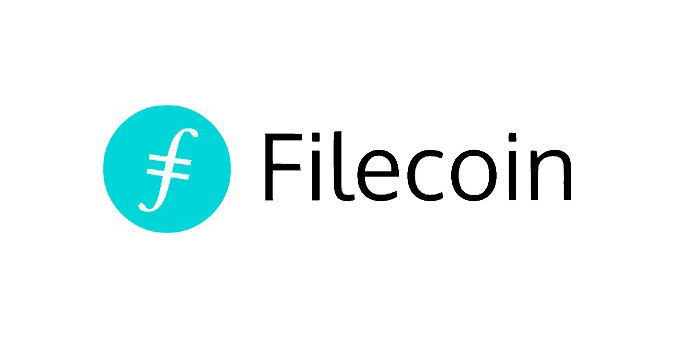
Project Description
In-depth analysis of IPFS: a new generation of Internet underlying protocolProject Description
founder
Filecoin is a distributed network designed to store the most important information of human society
, Filecoin is a distributed storage network based on IPFS and the incentive layer of IPFS.IPFS,LIBP2Pfirst level titleFilecoin 。
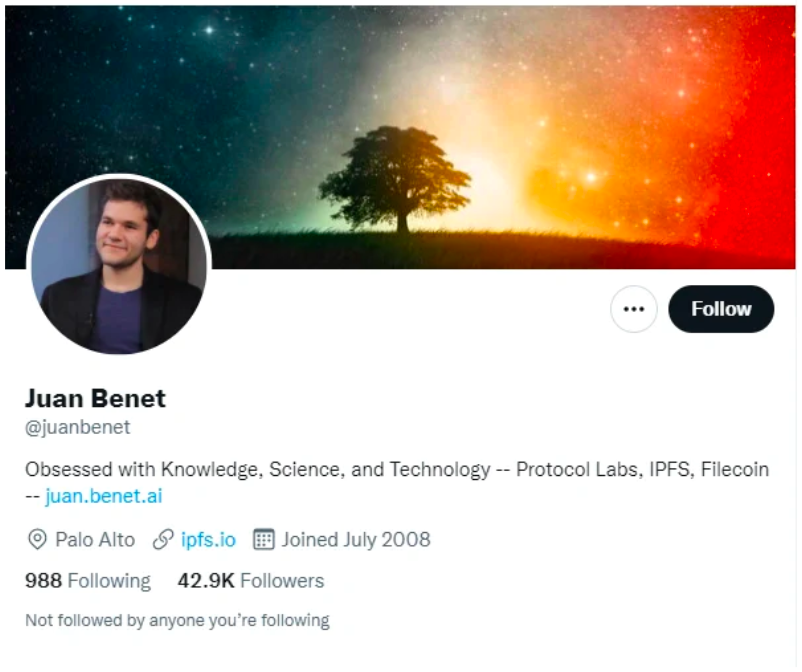
Juan Benet (Juan Bennett). Juan is the founder and CEO of Protocol Labs, a computer science graduate from Stanford University. Juan is not as well-known to our world as Satoshi Nakamoto and V God, but Juan's future influence is likely to be on the same level as Satoshi Nakamoto and V God.
, IPLD, CoinList (a token sales and investment platform, Filecoin is also fundraising on this platform), SAFT (legal framework for token raising),
filecoin-mechanism introduction
Flexibility and Scale Without Compromise
The Filecoin network consists of a large number of diverse storage providers and developers. Together they create a strong and solid service.
Store data safely and securely
Cryptographic proofs ensure your data remains available and unaltered over time
Proof of time and space
Verifies that files have been stored intact and have not been tampered with for a given period of time
Verify the agreed number of backups for stored files
verifiable behavior
The Filecoin global blockchain can verify proofs and automatically correct errors when necessary
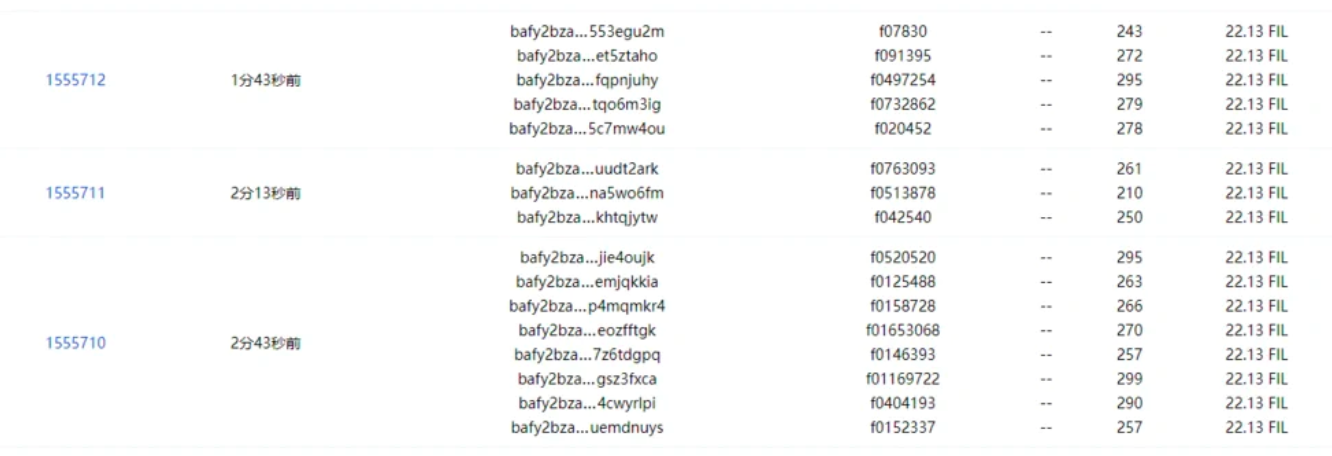
Innovative consensus mechanism and chain structure
Innovative consensus mechanism and chain structure
expected consensus
Expected Consensus (EC: Expected Consensus) can also be understood as an implementation of PoS (7 here S can be understood as Storage Service, and the contribution of storage service). The goal is that the rights and interests of miners producing blocks are proportional to their contribution to storage, that is to say, the proportion of the storage space used by the mining machine to the total space used in the entire network is the proportion of the mining machine that can produce blocks. probability. And each round does not necessarily generate just one block, but a tipset, and a tipset can contain multiple block structures."As shown in the example above, a tipset with a height of 1555710 has produced 8 blocks, each block is produced by a different miner, and a total of 1936 transactions have been accumulated. A tipset period is 30 seconds, and the TPS currently being used can be as high as 64.5, which is about the same level as the TPS currently being used by Binance Chain."tipset structure"In 2015, a paper titled "Secure High-Rate Transaction Processing in Bitcoin" (Sompolinsky, Zohar) was published, which made a new point of view popular in academia: no longer use the blockchain in the blockchain system Think of it as a chain structure, but think of it as a directed acyclic graph structure (DAG)."According to this point of view, in the blockchain system, the longest chain is no longer a sign to judge whether the blockchain is valid, and the most
Heavy
The chain is the sign to judge whether the blockchain is valid. here the so-calledHeavy
It is a standard calculated according to the GHOST algorithm. In layman's terms, the chain that contains the most blocks is the effective blockchain. This is where the consensus mechanism of Filecoin comes from.
Over time, new generations of family trees grow, called tipsets, a system that is unique to our network.
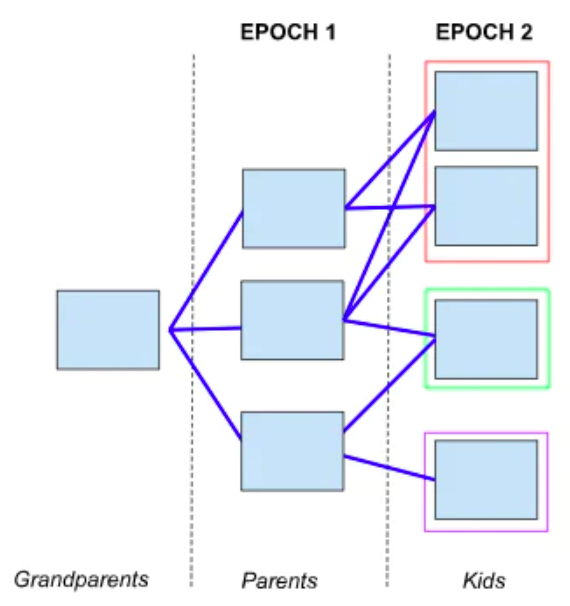
figure 1
image description
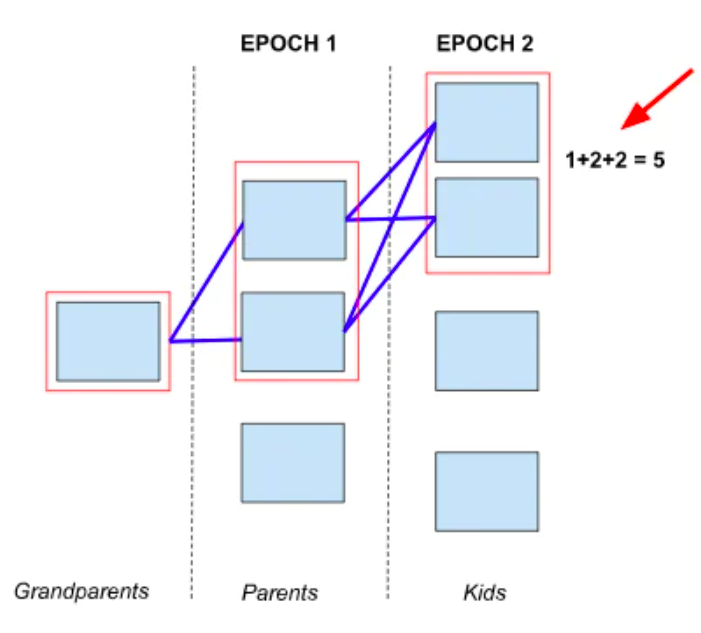
figure 2
image description
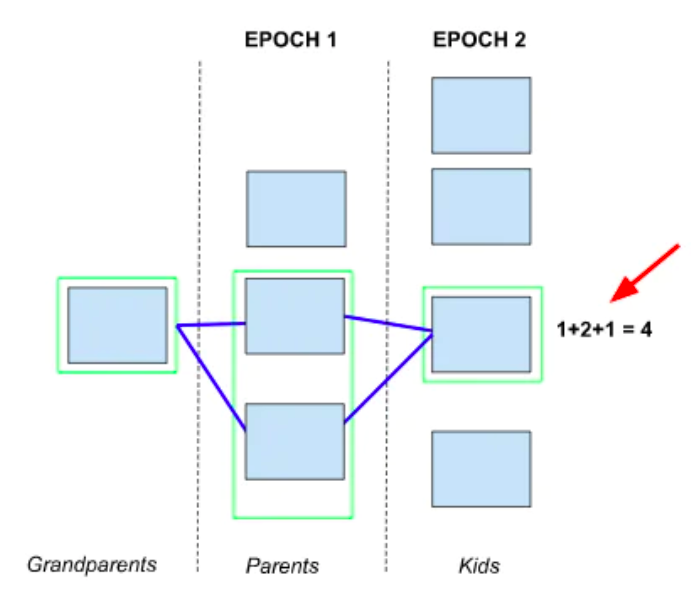
image 3
image description
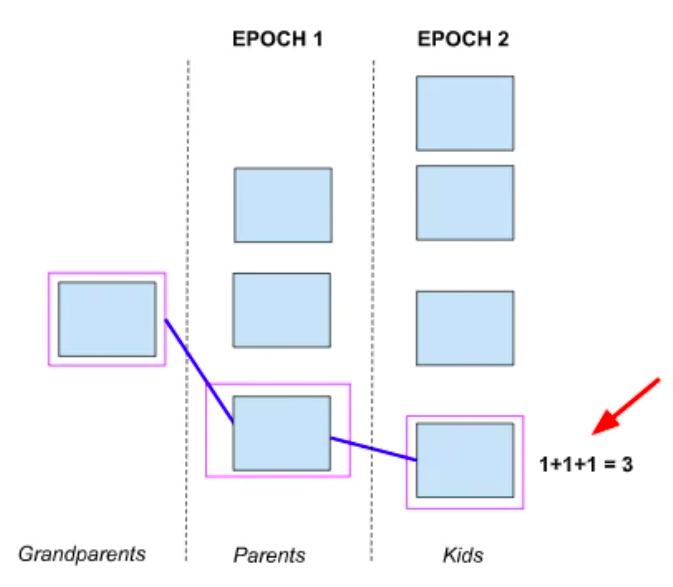
Figure 4
The second tipset in Figure 4 below has a total weight of 4 (one grandparent, two parents, one child)
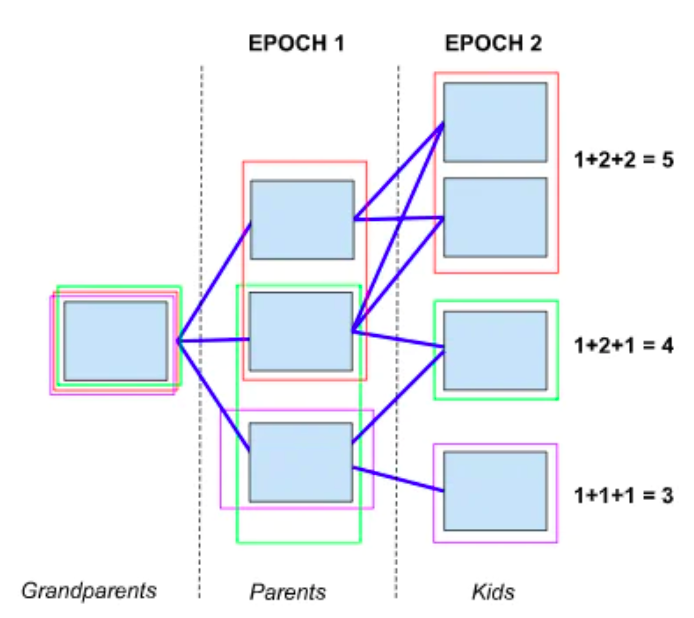
image description
Figure 4
Finally the diagram in Figure 5 provides a comprehensive view of this chain, in epoch 2 the first deck wins, although this is not confirmed until the next epoch.
Figure 5
Like Ethereum, the system encourages collaboration and increases overall chain throughput by ensuring that no work is wasted. Furthermore, since a tipset requires all its blocks to have the same parent and be mined at the same height, the chain is able to converge quickly in case of a fork.
Lay a solid foundation for the information of human society
Lay a solid foundation for the information of human society
Filecoin provides a foundation for important public data such as publicly accessible scientific data, innovative mass media, historical archives and archives, and more.
Determined by supply and demand rather than corporate pricing departments
Determined by supply and demand rather than corporate pricing departments
Filecoin lowers the entry barrier for storage providers and turns cloud storage into a commodity. This allows new market entrants to easily compete with existing players.
Storage providers compete fiercely for your needs, storing your data at the best price and offering flexible options.

And all of this is done on a transparent global marketplace.

A storage market that is visible and fair to all
A storage market that is visible and fair to all
Filecoin creates an incentivized market for utilizing spare storage space. By increasing supply, we can meet growing demand at lower prices.
It can be seen from the figure that the global distribution of centralized cloud services is not decentralized, users are far away from the server, and it is with the service provider to decide the price, service scope and who can use its services.
A more open market is needed, not just a few mega-corporations dominating our digital future.
The combination of Filecoin and the peer-to-peer distributed network protocol IPFS forms a more efficient and secure network that does not need to be controlled by the enterprise
The Filecoin network allows anyone to become a storage provider and achieve economies of scale in a way that competes for business
Content addressing and cryptographic proof-of-storage ensure data is stored securely and correctly over long periods of time
filecoin-interaction process
Filecoin interaction process
When users store data, they can see the quotations of each miner
Miners compete with each other to win storage tickets, and users will choose the most competitive miner.
The transaction is made, the user sends the data, and the miner stores the data
Miners must prove they stored data correctly to receive Filecoin rewards
The Filecoin network uses cryptographic proofs to verify that data is stored securely
Miners submit their storage proofs to the network through new blocks and verify new blocks sent by the network
Miners earn transaction storage fees over time and have a chance at block rewards
When a user needs a certain file, he can search for the miner who stored the file
This keeps the file closer to the user who needs it
Token Economic Model
Data spreads where it is needed more. As data flows around the world, data acquisition will continue to be optimized along with the market
Token Economic Model
Token Economic ModelFIL
Data as of March 30, 2022Token Information
Contract address:0xc944e90c64b2c07662a292be6244bdf05cda44a7
Token name:270 million / 2 billion
Market value: 6,856,262,751
Contract address:Market value ranking:
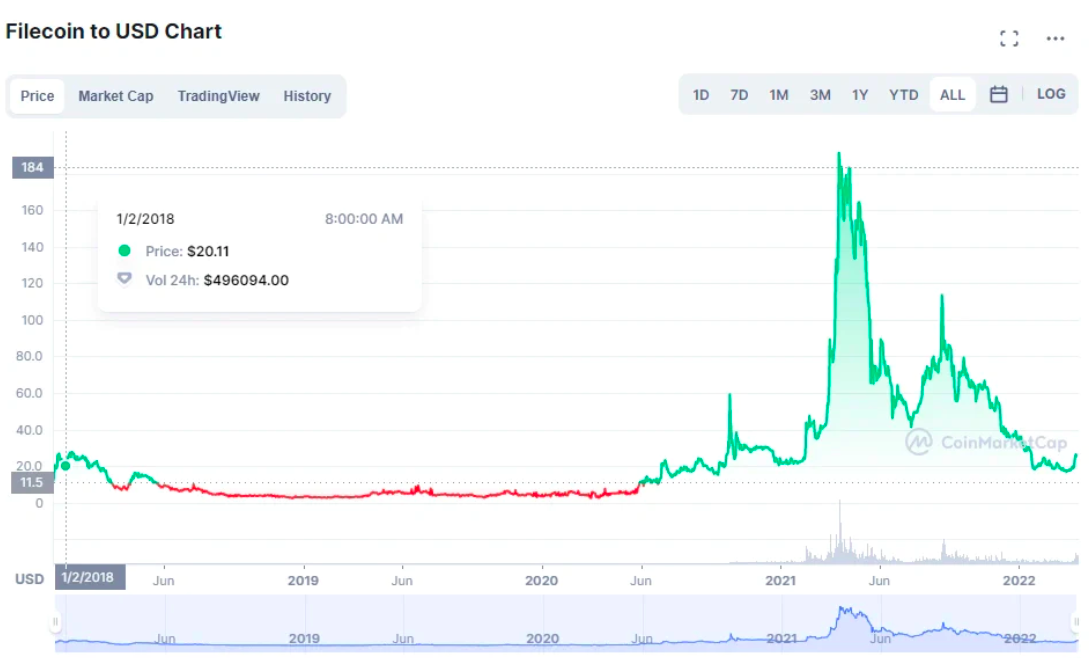
Market value:
**price fluncuation:
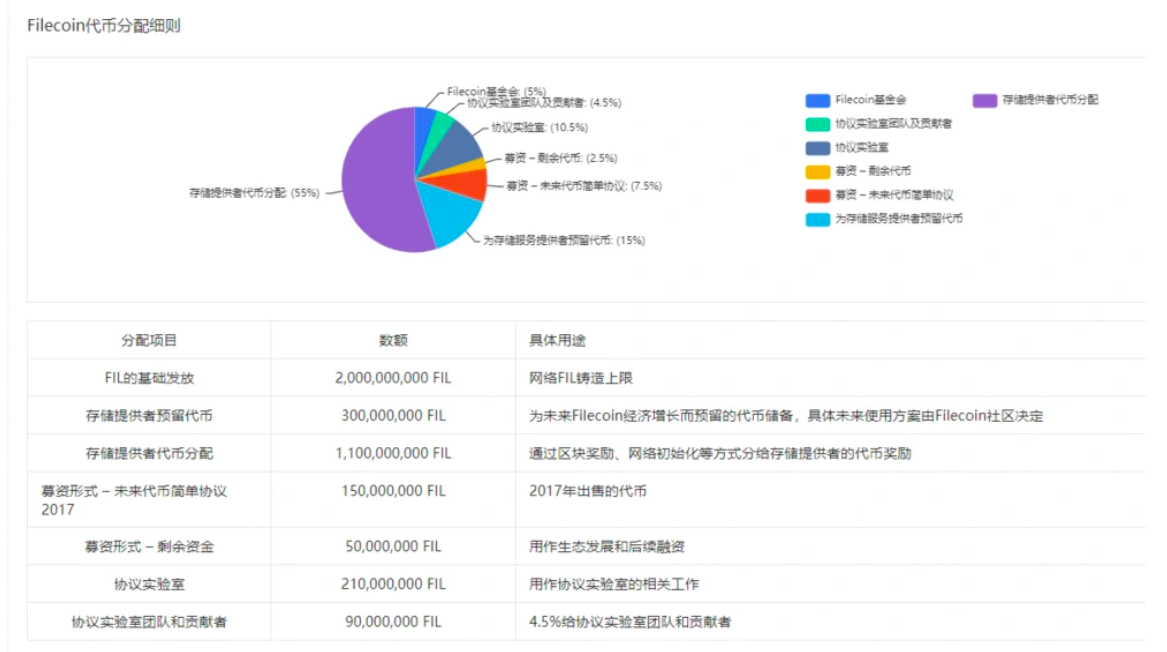
Token distribution
Token distribution
Of the total 2 billion FIL, 70% is used for miner rewards (of which 15% is reserved for users), Protocol Labs gets 15%, public and private investors account for 10%, and the foundation retains 5% for ecological construction. 1.1 billion will be used as block rewards, and 300 million will be used as storage reserve rewards.
token function
token function
Filecoin currently has three functions in the ecosystem
The block packaging verification function of the public chain
Function to store files
Function to retrieve files
In order to achieve and optimize the above three functions, the official has designed a series of reward, punishment, mortgage, and lock-up mechanisms.
On top of these three basic functions, in order to stabilize the long-term value of tokens, the official Filecoin team has made corresponding optimization adjustments.
Pre-stake: FIL tokens need to be pledged in advance to start the operation of the mining machine.
Block reward lock-up: Miners get block rewards (about 11 FIL/block), which are released in 180 days, and they can get all rewards after 180 days. In order to alleviate the predicament that a large number of mining machines could not be turned on in the early stage, it was decided to immediately release 25% of the block rewards to miners to ease the demand pressure on the secondary market.
Consensus mechanism: Different from the POW mechanism of Bitcoin, the consensus mechanism adopted by Filecoin is the space-time proof in the proof of storage. Under this mechanism, the effective storage space of the miners is the source of competitiveness, which can effectively avoid the energy waste like the POW network .
The main income of miners in the initial stage of Filecoin network operation comes from block rewards and storage rewards. With the gradual improvement of ecological construction, the corresponding proportion of retrieval rewards in the later period will gradually increase, surpassing block rewards and storage rewards.
fileocinmarket
Fileocin Marketplace
Cloud storage (a market of US$75 billion in 2021, and the market size of cloud storage is expected to be nearly US$170 billion in five years)
Filecoin has created a powerful decentralized dynamic cloud storage service platform. Filecoin reduces storage prices by encouraging competition among all storage space providers, including potential online storage brought by new entrants.
Smart contracts for escrow, auctions, insurance, gaming, finance and more.
Algorithmic CDN ($23 billion market by 2021)

filecoin optimizes content delivery through its incentives, auto-scaling and global CDN.
Pain points of existing nft
Pain points of existing NFT
Juan, founder of IPFS: "NFTs that are not on IPFS are not your NFTs"
So, where is the underlying data of the unique and expensive NFT stored, so as to truly ensure that the NFT will not be invalidated due to the shutdown of the website?
We found opensea and found that people can easily change the picture, even if it is in auction state or the picture does not belong to the user. What is the reliability of NFT storage assets?
Possibility of fvm (smart contract provable storage --fvm)
Possibility of FVM (smart contract + provable storage = FVM)
FVM opens up endless possibilities, from programmable storage primitives (e.g. storage bounties, auctions, etc.) **Data-centric Decentralized Autonomous Organizations (DAOs)** to Layer 2 solutions such as reputation systems, data availability sampling, computational structures, and incentive-aligned content delivery networks, and more.
️ -possibility of fvm-
▶️ Possibility of FVM
Decentralized storage and computing
Storage providers can register with the computing network through FVM participants. Compute clients publish jobs to participants. A mechanism would distribute work to providers, and once executed, providers would issue proofs to claim rewards.
NFT local storage
Coexist the content of the NFT with a registry that tracks its content.
time-locked data retrieval
This dataset is only unlocked when the company makes the results public, for example.
Data DAO
Since shares in a data DAO can be tokenized, the value and utility of data can be objectively expressed and traded in the market in exchange for services performed or provided on the data.
FVM implements all the ingredients to make Data DAO a reality. By creating composable layers that can be combined to form different types of DAOs, the possibilities for breakthroughs are enormous.
Enable L2 networking
By deploying commitments or onboarding participants on FVM, Layer 2 solutions can (a) commit their state on-chain via verifiable proofs, (b) distribute participant rewards, (c) verify fraud proofs, etc.
Cross-Network Interoperability Bridge
Building a set of FVM participants that can process cryptographic primitives and data structures of other chains via IPLD (Interplanetary Linked Data) opens the door to a new generation of cross-chain web3 use cases. For example, NFT registries could prohibit transactions unless it can be proven that the underlying asset is stored on Filecoin.
new storage market
Along with some protocol refactoring, FVM will be able to create new market primitives and protocols, such as:
Storage bounties, where storage providers compete to win deals and lower prices for customers.
Bulk discounts further reduce prices for purchasing multiple divisions at once.
Sector rebates, once a customer purchases N sectors within a certain time period, the provider refunds the customer (probably Data DAO!)
permanent storage
With Filecoin participants, the responsibility for keeping valuable data alive is shared. Permissionless code running autonomously on-chain guarantees storage persistence and updates, and thanks to content addressing, there is no risk of modifying or changing the underlying dataset.
Funding mechanism and decision-making can be combined with data DAO and pledge agreement to realize the mechanism of one-time payment and permanent storage.
copy worker
Replica workers solve this problem by charging a small fee to act as mediators, saving clients the time and expense of negotiating multiple deals. Instead, replication workers can automatically replicate across the network based on user-defined policies based on replica count, region selection, latency, price, and more.
maintenance worker
Repairers solve this problem by automatically updating the process of expiring or terminating deals - saving customers the time and expense of manually updating deals for the next 2, 5, or 10+ years.
pledge agreement
insurance agreement
This can help storage providers fund upfront capital costs such as collateral for Filecoin Plus transactions, while allowing stake pools to capture yield potential.
credit loan
Provide credit loans to storage suppliers, mining nodes have continuous profitability, and even launch credit loans to advance the future income of nodes.
insurance agreement
Insurance agreements can help storage providers finance these upfront costs from investors, or distribute the risk of failure among the wider community. Investors (or DAOs) can earn an income stream by purchasing the aforementioned exposure in exchange for recurring fees.
EVM Compatibility
Powerful WASM-based VM
FVM is a WASM-based polyglot execution environment for IPLD data. It is designed to support native Filecoin participants written in languages compiled to WASM, as well as smart contracts written for foreign runtimes including the Ethereum Virtual Machine (EVM), Secure EcmaScript (SES), and eBPF environments.
EVM Compatibility
FVM supports EVM smart contracts out of the box. It emulates EVM bytecode under the hood and supports contracts written in Solidity, Vyper, and Yul.
You can continue to use all the developer tools you are familiar with: Remix, Truffle, Hardhat, OpenZeppelin SDK, etc. Most smart contracts ported to Filecoin do not require changes or audits.
fvm roadmap
FVM Roadmap
The Filecoin virtual machine is being gradually introduced. This minimizes the risk of network outages and provides plenty of opportunities for developers to get involved early.
January 2022
Milestone 0: Launch Lotus testnet (canary) supporting FVM
2022
March 2022
June 2022
Milestone 2: Ability to deploy user participants and EVM contracts to mainnet
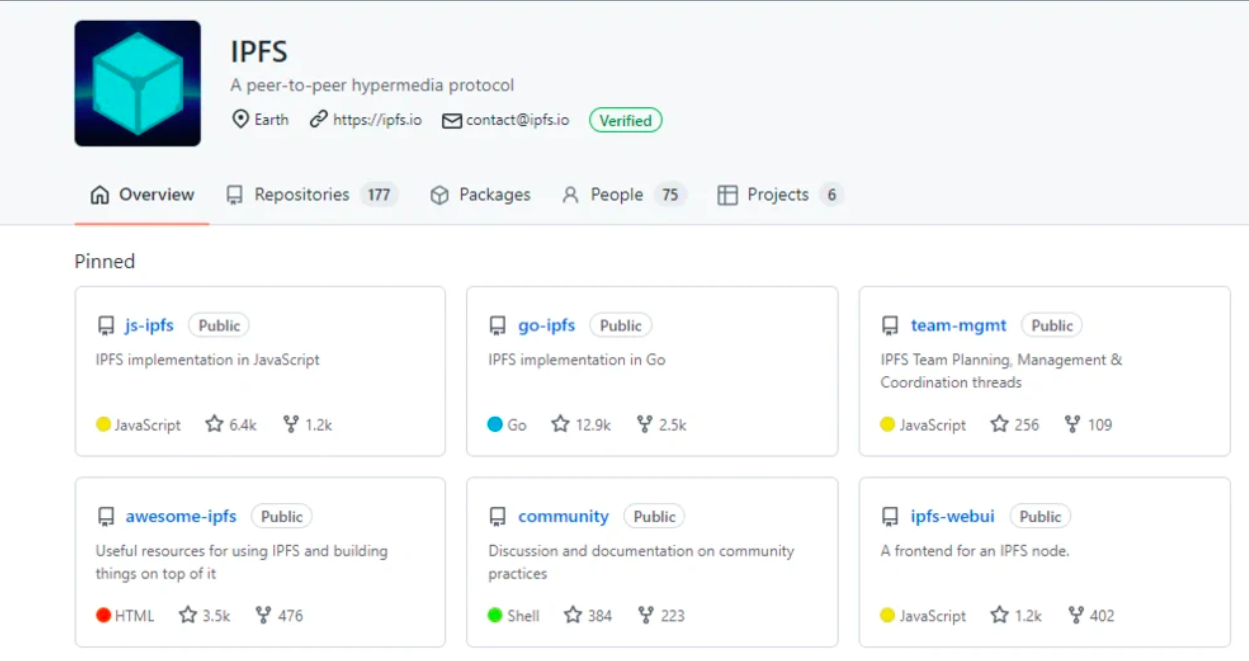
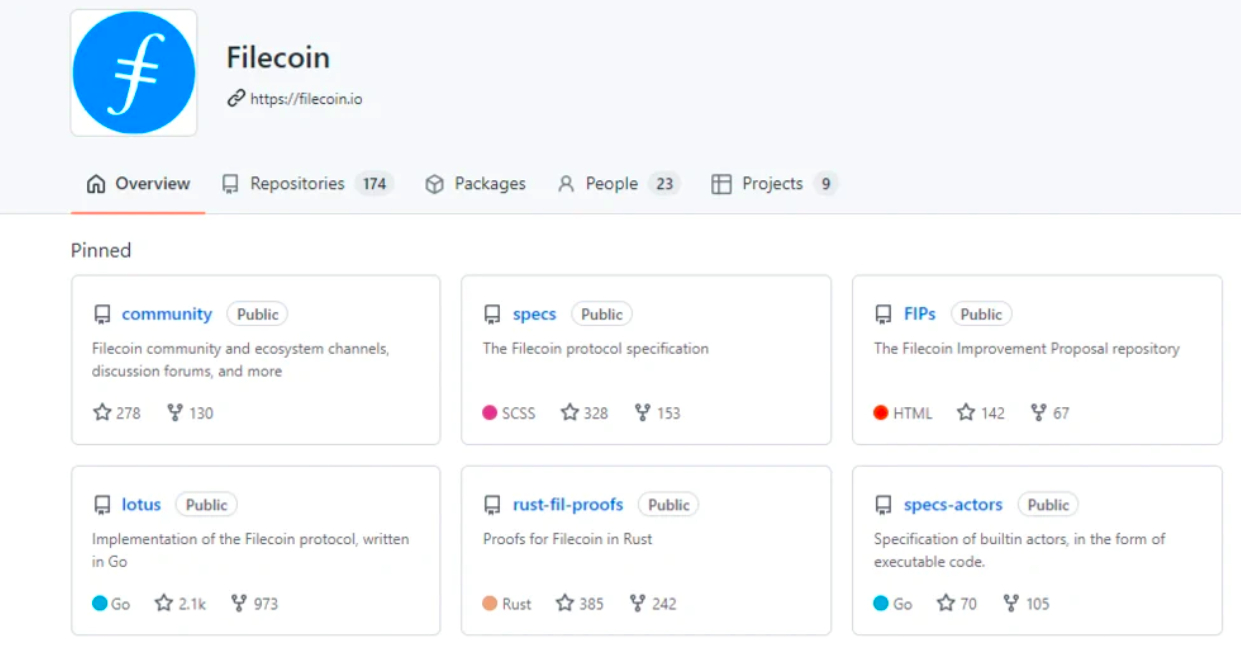
Filecoin
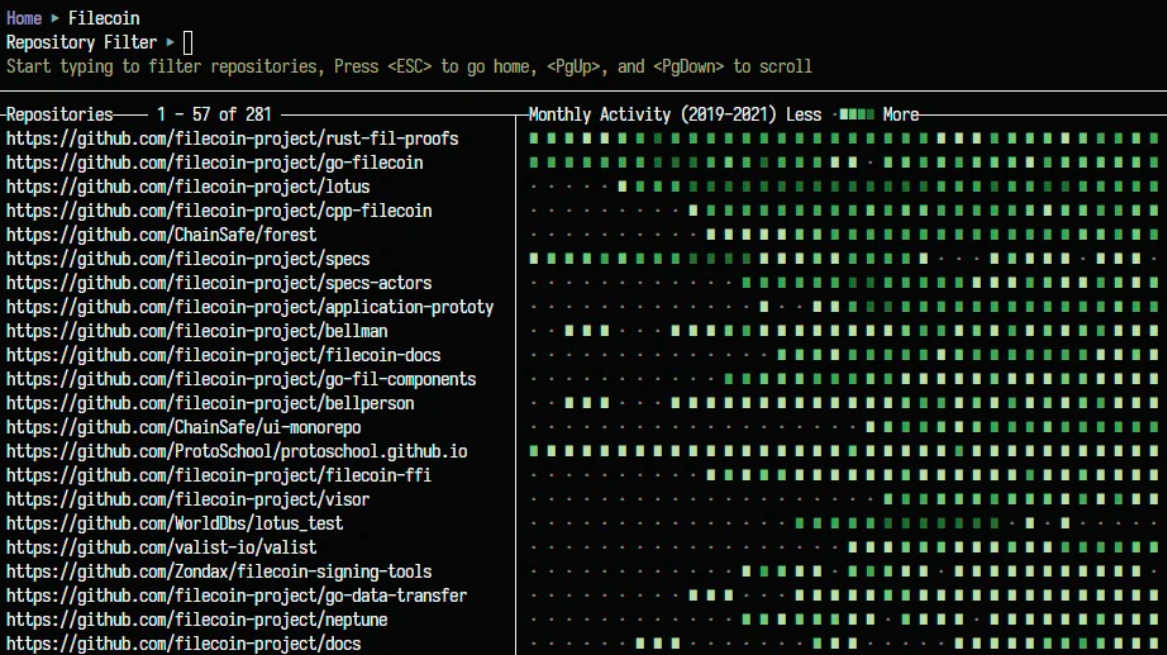
IPFS
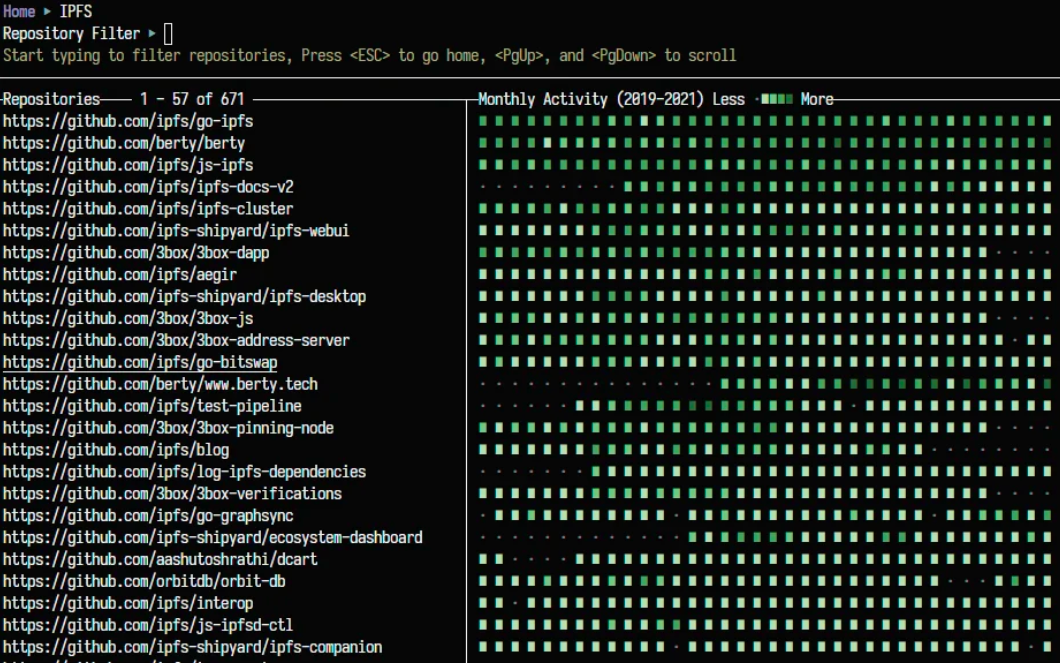
Libp2p
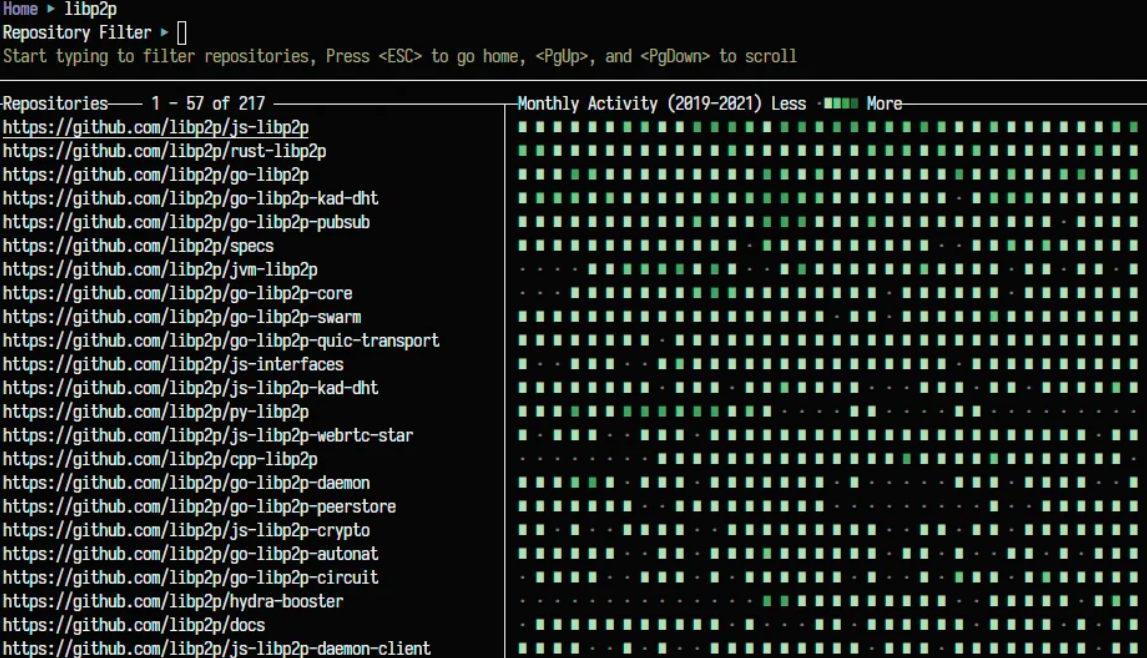
Developer side
According to the github data, the number of contributors, the number of stars, the number of forks, and the number of code submissions of developers of IFPS+FIL are second only to btc and eth among all chain projects, far exceeding other blockchain projects. (In fact, libp2p, ipld, multiformats, etc. are not included)

Competitive Analysis

1EB=1024PB
1PB=1024TB
storage comparison
Storage Capacity and Cost
storage
Filecoin's storage capacity is as high as 16EB (not including the effective storage capacity of IPFS), and its volume and cost have been able to challenge the existing cloud storage market, and decentralized use of hard disk space to provide better data than centralized providers such as Amazon and Alibaba. lower price. The effective storage space of Filcoin is 290,000 times that of AR.
Filecoin ecological panorama
Filecoin ecological panorama
storage
OpenStreetMap:As stated on the official website, Filecoin is a distributed network designed to store important information in human society. People can use Filecoin to store and retrieve data, and together build a powerful and active distributed storage market.
The Filecoin network is composed of a large number of storage providers and developers. The encryption proofs used innovatively can ensure the safe and reliable storage of data for a long time. At present, the Filecoin network has stored a lot of data.:**NFT storage: **The basis of applications is data, and the basis of data is storage. This is the fundamental reason why emerging concepts such as NTF and Metaverse are actively seeking to cooperate with IPFS. This process is not a one-way wishful thinking, but a two-way sympathy. When Filecoin launched the free NFT storage service NFT.Storage, OpenSea, the largest NFT trading platform, also launched the function of "freezing" NFT metadata, allowing NFT owners The author can correctly decentralize NFT through the distributed storage protocol and the interplanetary file system.
GnomAD:OpenStreetMap is built by a group of mappers who contribute and maintain data about roads, trails, cafes, train stations, and more around the world. Contributors include enthusiast mappers, GIS professionals, engineers running OSM servers, humanitarian personnel mapping disaster-stricken areas, and more. The Filecoin network will store a copy of the full OSM dataset, facilitating map preservation and distribution.
application
Brave
Project Gutenberg
Project Gutenberg is the world's oldest digital library with over 60,000 free e-books. Thousands of volunteers have digitized and proofread the eBooks, adding an average of 50 new books per week. Now Filecoin provides reliable hosting services for Gutenberg's library, ensuring that many of the world's great documents can be strongly preserved for everyone to use.
ION
The Genome Aggregation Database (gnomAD) is a consortium of researchers aimed at aggregating and harmonizing exome and genome sequencing data from various large-scale sequencing projects and making summary data available to the wider scientific community. The Filecoin network will store a copy of the v3 short variant dataset, which includes 71,702 genomes from unrelated individuals sequenced as part of various disease-specific and population genetic studies.
application
Slate
Brave is a blockchain browser that focuses on blockchain privacy protection. It already has more than 20 million users. Brave has added support for the interstellar file system IPFS, integrating IPFS into desktop web browsers for Windows, macOS and Linux .
Brave supports the native IPFS protocol, allowing people to use the distributed network more easily and simply. This realization marks an important step in the development of a more resilient, user-first Internet.
Filswan
ION is a public identity network that provides a decentralized public key infrastructure via Decentralized Identifiers (DIDs) and the Sidetree protocol on top of the Bitcoin blockchain.
Since 2019, IPFS has been working with ION to support ION to use IPFS to store data. The working principle of ION is to aggregate transactions into batches, add these batches to IPFS, and then write the IPFS content identifier (CID) into the blockchain for batch processing, and ION is paired with the local go-ipfs node, Used to publish data to make it available to the wider IPFS network.
Livepeer
Slate is an open source storage system based on Filecoin. Slate is the first storage application designed to encourage collaboration and research across distributed networks.
Powered by IPFS, Filecoin and Textile, the Slate network is open and available to everyone for data storage and transactions. Currently, 500GiB of real data has been stored.
Opera
Filswan provides a decentralized edge infrastructure marketplace and software to move data storage and analytics as close as possible on Web 3.0.
Currently, the functions that Filswan has completed and is open to the public are transaction bidding, miner reputation, IPFS caching, S3 compatible storage sharing and backup to the Filecoin network, payment gateway.
FileHive
Livepeer is an open video streaming infrastructure networking. Networking participants, developers and broadcasters can use Livepeer's system to control their own experience while reducing costs by 50 times. Through the Livepeer peer-to-peer infrastructure, networked participants can securely interact with each other in the marketplace on the Ethereum blockchain platform.
Opera was the first browser to include built-in crypto wallets in both its iOS and Mac browsers, with Android, iOS, and desktop versions, and the first to protect users from masquerading online cryptocurrency mining or "cryptocurrency mining." One of the browsers attacked by "hijacking".
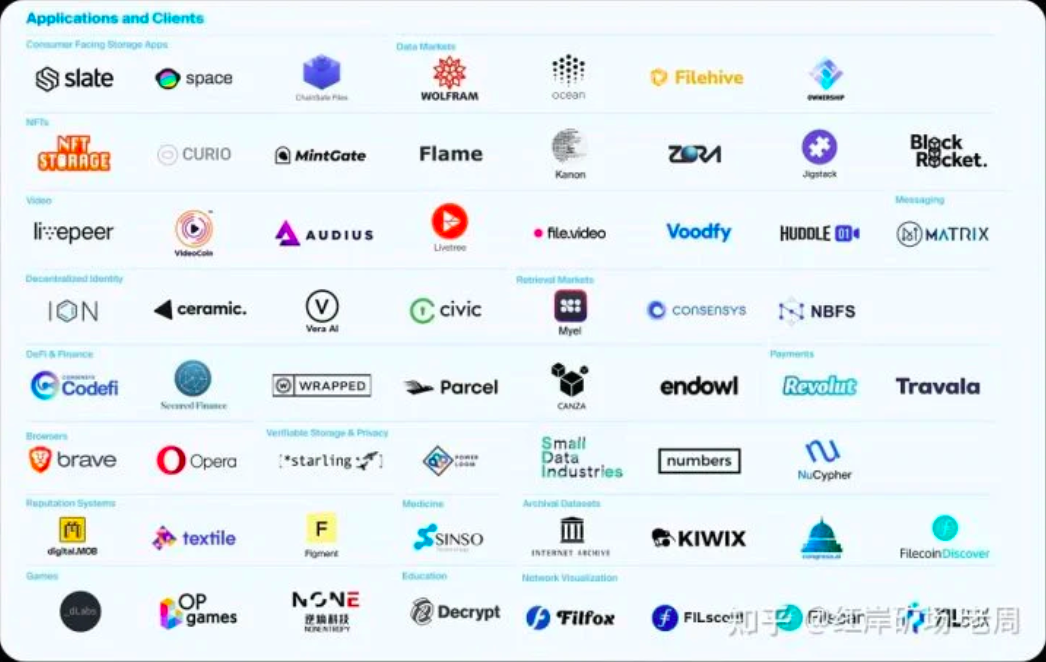
Ecological cooperation
Chainlink
Today, Opera for Android is live on the Google Play Store and supports IPFS by default.
FileHive is a Filecoin-based data marketplace built and maintained by OB1, the dapp development studio behind OpenBazaar and Haven.
Drand
Filehive is an open source website for uploading, maintaining, purchasing or granting datasets. Filehive originated from the Filecoin incentive project, built on top of Filecoin, Powergate and Loom. It leverages the Filecoin network to incentivize the storage and authorization of datasets, which are retrieved from the IPFS network.
ConsenSys
Ecological cooperation
Chainlink is integrating with Filecoin to enable a two-way connection between the Filecoin network and smart contract-enabled blockchains such as Ethereum.
Ethereum Foundation
Drand is a Randomness Beacon, a service that provides publicly accessible randomness for use by third parties. drand is unique in that it generates randomness by combining contributions from a network of independently operating servers. This means drand incorporates the strength, security, and resilience of distributed networks into the randomness generation process. In many ways, this makes drand an industry first for randomness-as-a-service.
In 2020, Protocol Labs expanded its collaboration with ConsenSys, a new collaboration that integrates Filecoin's distributed data storage and retrieval marketplace into ConsenSys' Ethereum product stack.
developer tools
Textile
Ethereum Foundation
Truffle
It is reported that on November 1, 2018, at Devcon, the annual conference of Ethereum developers held in Prague, Justin Drake, a researcher at the Ethereum Foundation, announced the preliminary design of an application-specific integrated circuit (ASIC). , these designs will power the upcoming "beacon chain" Ethereum technology. Filecoin will cooperate with the Ethereum Foundation to share half of the project research and development costs.
Orbit
Of course, the cooperation between the Ethereum Foundation and Filecoin is far more than that~
developer tools
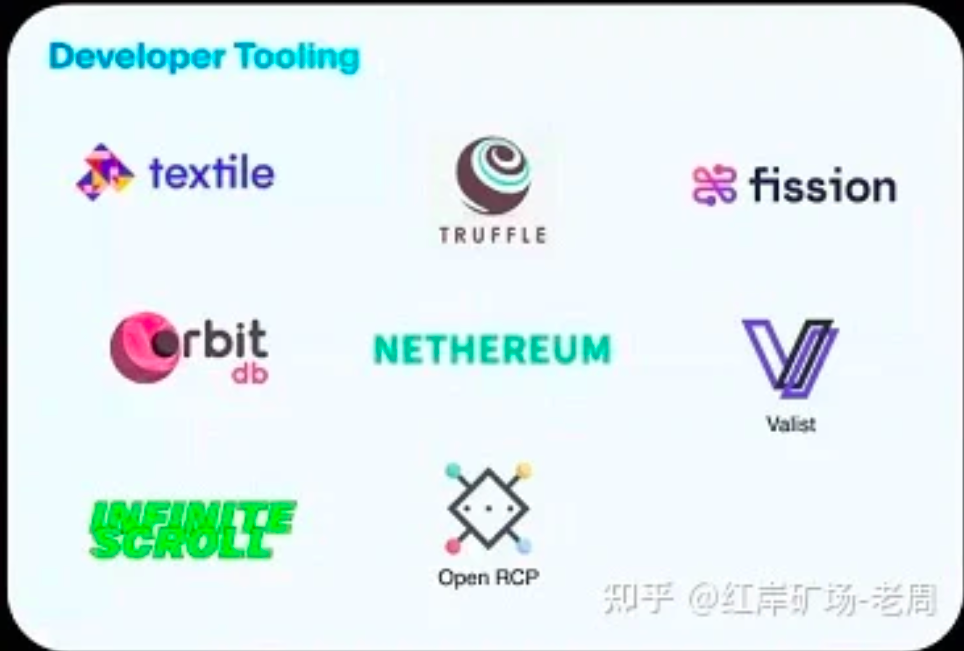
Textile is a company dedicated to changing the way data runs on the network. They have partnered with Filecoin. The Filecoin toolkit on Textile allows application developers to store data on Filecoin and provides them with APIs to access the data they have built. in the platform.
Truffle is an Ethereum smart contract development tool, and it has reached a cooperation with Filecoin. Truffle will integrate the Filecoin network into its tool suite to help users deploy directly to Filecoin. Truffle will then add new features to Ganache so that users can easily simulate the Filecoin network during development and testing.
Orbit is a data platform. OrbitDB is a chat application derived from Orbit. It is a peer-to-peer database based on the IPFS protocol. It provides various types of databases for different data models and use cases. For developers, Orbit can develop A LAN anonymous chat network.
Forest
Orbit uses Ethereum and uport to register identities, track users and identity information. This is a demonstration of the powerful combination of IPFS distributed applications and Ethereum processing systems.
protocol version
Lotus agreement
Lotus is the most mature Filecoin implementation. The focus of Lotus is to prepare for specification participant upgrades and testing, to create a flexible state upgrade framework, and to develop Lotus-lite, which provides a Lotus wallet that can directly interact with miners, while No heavyweight components to maintain.
Forest is an implementation of Filecoin written in Rust, which uses a modular approach to build a complete Filecoin node in two parts:
Fuhon
· According to the Filecoin protocol specification, build Filecoin's security-critical systems in Rust, especially the virtual machine, blockchain and node system;
Venus protocol
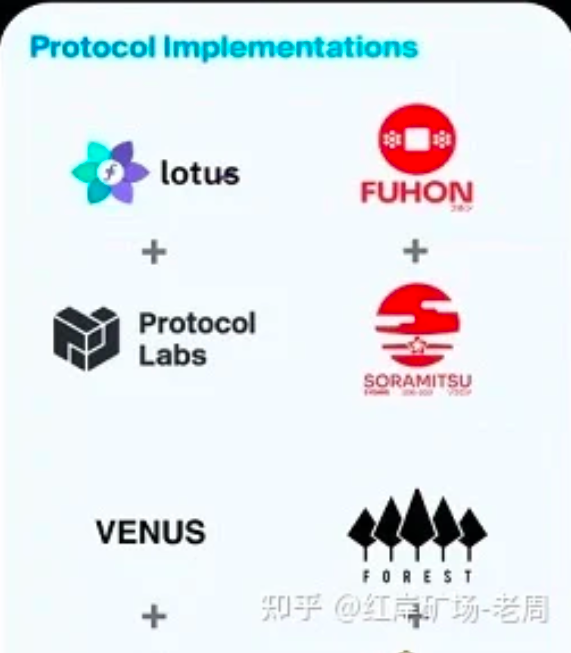
infrastructure
Fleek
Venus features that it can be built and run on most Linux and MacOS systems, but Windows is not yet supported, Venus verification nodes can run on most systems with at least 8GB of RAM.
Fuhon is a C++ Filecoin implementation developed by Soramitsu. All C++ dependencies are managed using Hunter. The feature of Fuhon is that it uses cmake to download the required libraries, no need to manually download and install packages.
Infura
Fuhon miners and nodes can be compatible with the new version of Lotus, and the implementation and operation have been tested for consistency to ensure interoperability; in addition, in the TLS patch, the connection between Lotus and Forest nodes is enabled, which means that Fuhon Both Lotus and Forest can be connected to each other.
infrastructure
Pinata
Fleek is an application mainly used to develop hosting websites, store and deliver files, and serve decentralized web services. His mission is to help everyone create web3.0 applications more easily and store files in distributed websites. This puts DWeb in the vanguard of "low code/no code" and accelerates the popularization and adoption of DWeb.
ENS
Most of Fleek's products and services are built on the Fleek stack of IPFS, Textile and Filecoin. In addition, Fleek officially announced that it will enable Filecoin automated archiving/backup for all outlets and storage on Fleek.
Infura is an online platform designed to provide developers with a variety of tools that developers can use to connect their applications to the Ethereum network and other decentralized platforms.
Infura passed a beta version of the Filecoin Network API, which allows developers to connect to the Filecoin mainnet and use the Infura dashboard to build Filecoin-based applications.
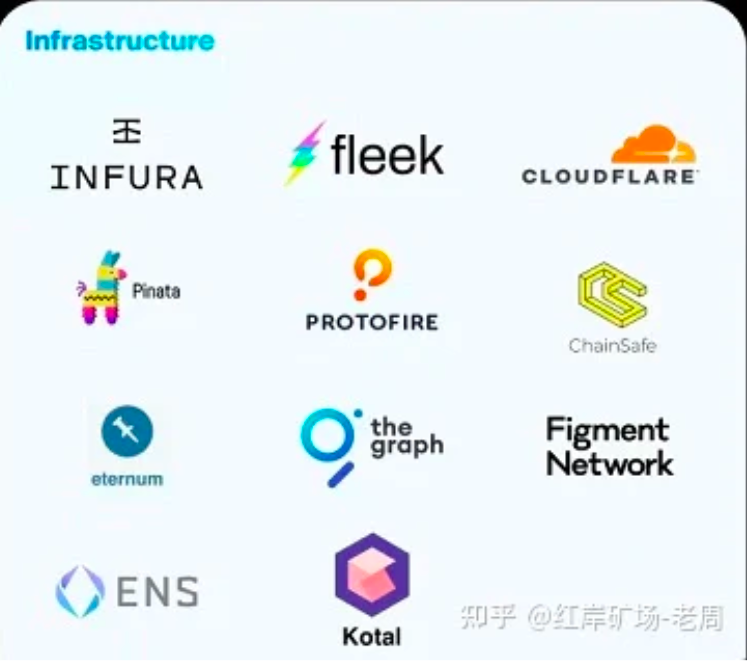
The full name of ENS is Ethereum Name Service (Ethereum Domain Name Service), which is a decentralized domain name service built on Ethereum. ENS provides a secure and decentralized way to resolve simple human-readable domain names into on-chain and off-chain address resources. Basically, ENS can assign a human-readable domain name to any machine-readable data (such as Ethereum address, metadata, content hash, etc.), and its function is similar to DNS.
We all know that the ethereum.org website is now hosted on IPFS, and users can access it through ethereum.eth of ENS.
The vigorous development of the ecology is the witness of the popularity, landing and popularity of the Filecoin network. We expect and believe that the Filecoin network will show a more vigorous growth trend.
project disadvantages
First of all, the complexity of the system is high, and the mining threshold is high. In addition to the necessary procurement hardware storage costs, miners also have to bear high proof costs (computing servers for space-time proofs) and the opportunity cost of pledged Filecoin losses.
Proof of replication, proof of time and space, etc. have a large transaction volume and occupy most of the filecoin network transactions.
The supply exceeds demand, and a large amount of junk data is stored (first, people who pay attention to Filecoin all over the world realize that Filecoin can indeed establish a very stable storage space, and second, the credit support of the entire Filecoin network represents everyone's confidence in the security of this network ledger. Approved. Just like Bitcoin, many people feel that Bitcoin mining consumes a lot of electricity)
The search market is not perfect enough, and it takes a long time to extract and access the original data, which needs to be unpacked. Now Protocol Labs is also focusing on promoting the Filecoin retrieval market, and it is expected to be officially launched by the end of this year to realize real-time data access.
Proof of replication, proof of time and space, etc. have a large transaction volume and occupy most of the filecoin network transactions.
Just storage, no computation, no complex functions
The above shortcomings have corresponding solutions, and the solutions will continue to be followed.
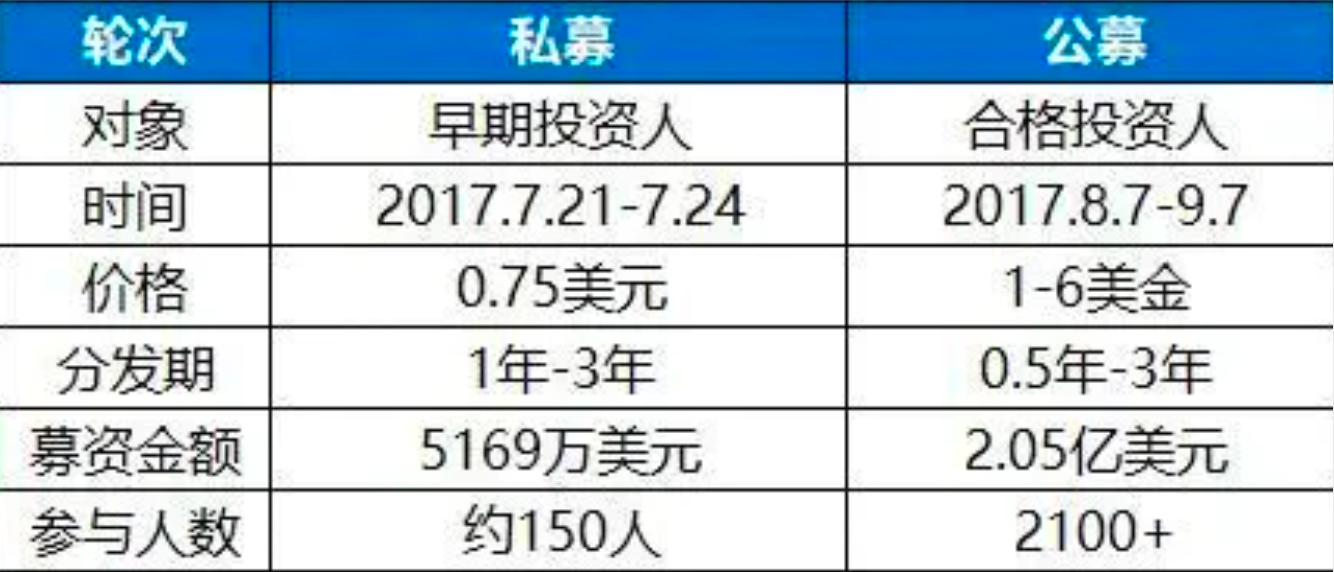
Team and Investors
**IPFS and Filecoin are products of Protocol Labs, and the development and research capabilities of Protocol Labs are top-notch in the industry. **Key members of the core laboratory team come from 13 countries/regions. Founder and CEO Juan Benet graduated from the computer science department of Stanford University, has two years of CTO experience (working at LokiStudio), and founded Athena. Other notable members include Matt Zumwalt, Nicola Greco, David Dalrymple, Evan Miyazono, Jeromy Johnson, Steven Allen and more. Consultants include Andrew Miller and Eli Ben-Sasson.
The IPFS (Filecoin) project is more favored by the capital market, and the investment lineup is luxurious:
The financing of Filecoin is divided into two rounds of private placement and public placement, with a total financing amount of more than 257 million US dollars. The same process as the IPO is adopted to ensure the legitimacy of the financing process. Institutional investors include Stanford University, Sequoia Capital, DCG Group, Y Combinator, A16Z, Winklevoss Capital, Union Square Ventures and other top investment teams.
Why are you optimistic about the follow-up market of filecoin
Why are you optimistic about the follow-up market of filecoin
The price fell to one-tenth of the highest point, which is a better entry opportunity (the market value is only 1/130 of btc, 1/59 of eth)
FVM will be launched soon (smart contract + provable storage), which will greatly improve the consumption scenarios of fil
With the launch of ETH2.0, a large number of idle graphics cards will likely be transferred to filecoin mining
Development ability, innovation degree, and execution ability all belong to the first echelon (from the proof of work of the code, it is also far underestimated)
The founder, Juan, has his own influence
IPFS, the most basic framework of web3.0, replaces http (http brings the prosperity of the Internet, and ipfs can bring a lot of imagination to web3)
Compared with the traditional cloud storage network, the cost is lower, and the storage cost is lower. Compared with AR permanent storage, it is more market-oriented and more flexible. After the launch of FVM, filecoin can also support permanent storage
The effective storage capacity of filecoin is as high as 15.54EB, which is comparable to traditional cloud storage platforms
IPFS partners (the top browsers all cooperate with IPFS, Google, Firefox, Brave, etc. Brave users can directly access IPFS content by analyzing URIs beginning with ipfs://)
The project party used by libp2p (the top blockchain leader project, eth, dot, metamask, etc.)
More decentralized and more transparent, you can build a decentralized full stack on filecoin (existing dapps are all centralized front-end non-transparent + decentralized back-end)
Developer data, the number of stars, the number of code branches, and the number of code submissions are very healthy (second only to btc, eth)
With the release of filecoin V15, the snap deal function can utilize the garbage data stored in fil, which also greatly improves storage efficiency
filecoin market data analysis
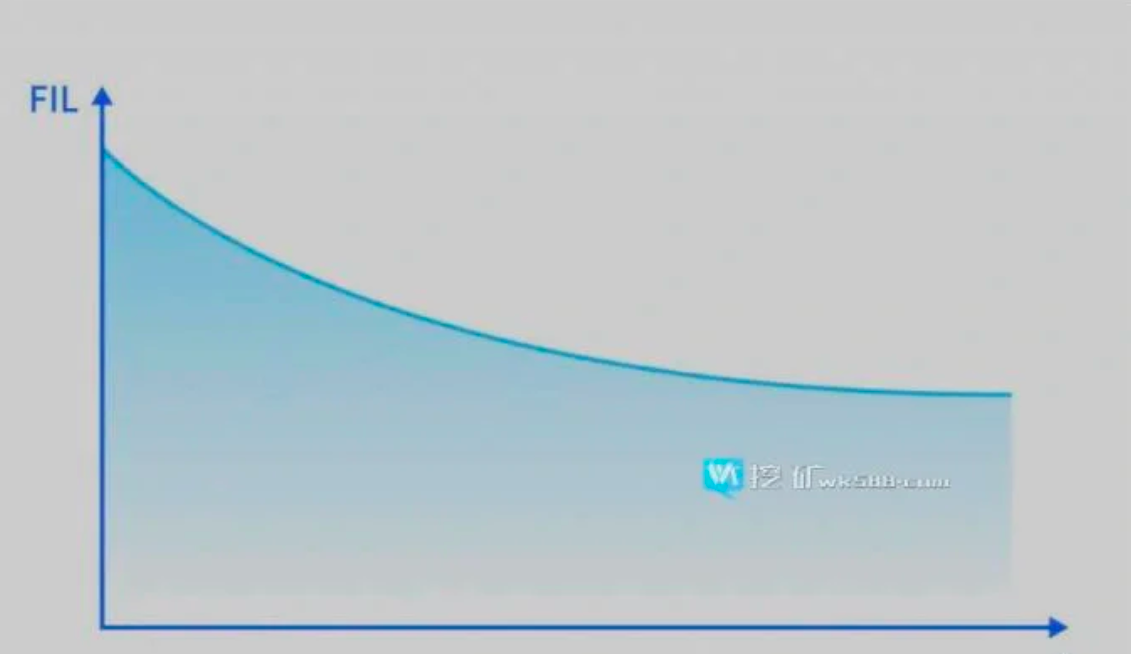
filecoin market data analysis
20.26 * 4.85 * 2 * 60 * 24 * 365 = 103,291,filecoin-inflation rate
Filecoin's inflation rate
The filecoin output curve is shown in the figure, gradually decreasing, halved in 6 years (the specific release speed is related to the filecoin baseline, because it has exceeded the baseline, according to simple calculation)
Assuming that only block mining rewards are considered, based on the current liquidity, the current block reward is 22.11, and the block reward is expected to be 18.42 in one year. Taking the average value, the block reward is 20.26, and filecoin is a tipset At present, it contains an average of 4.85 blocks, and the generation time of a tipset is 30 seconds, so the total reward for filecoin mining for one year is
25% of the mining rewards will be released immediately, and 75% will be released in 180 days. Therefore, the circulation generated by mining in one year only accounts for 80% of 103 million, the circulation release is 82.4 million, and the inflation rate is 33.63% (not shown here) Consider the liquidity that will be reduced by the new computing power mortgage and burning, the liquidity released by fund lockup, and the liquidity that will be released by the linear unlocking of node rewards that have not yet been released).
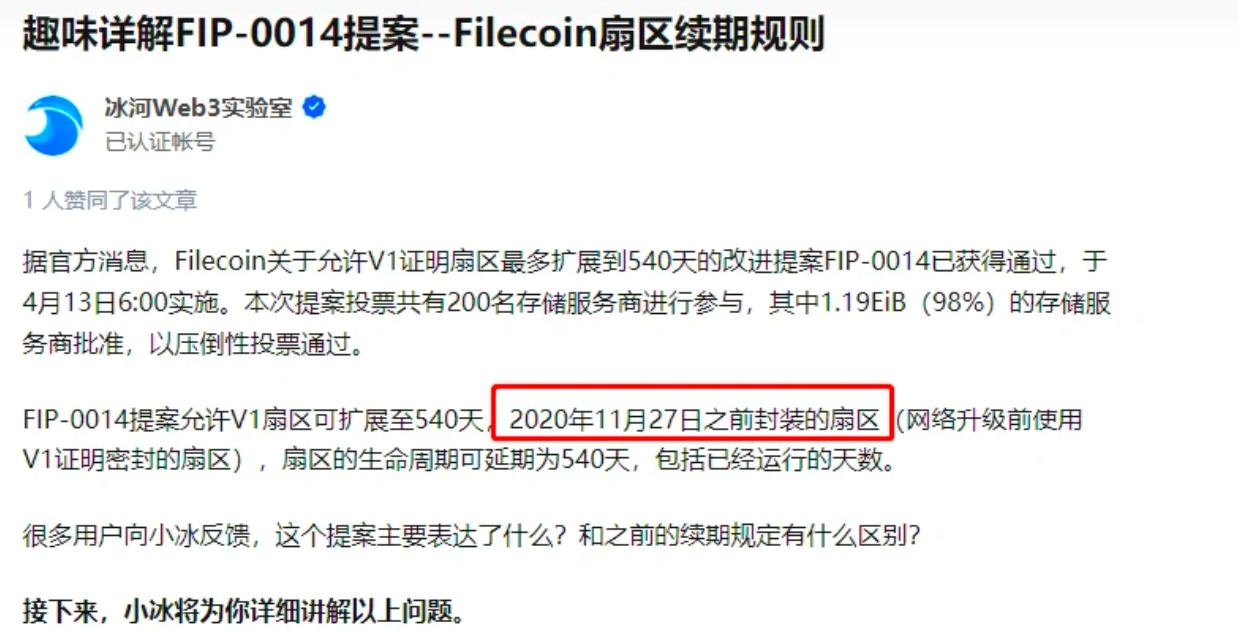
Filecoin mining annualized income
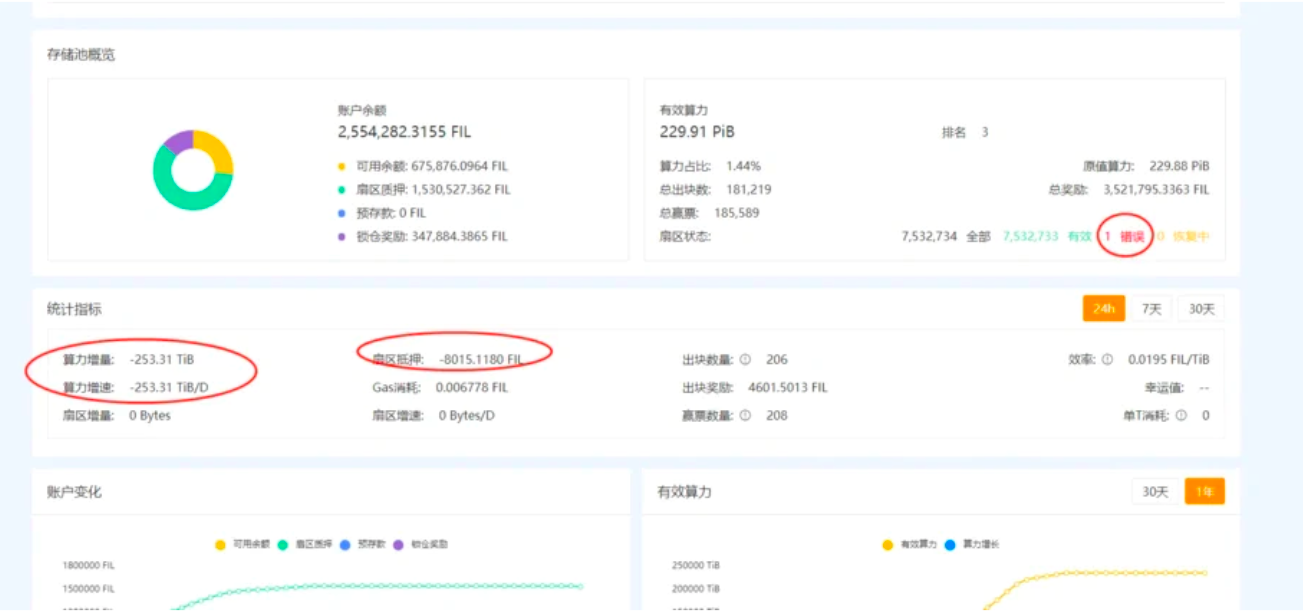
Taking 1T of computing power as an example, the mortgage cost of 1T of computing power is 4.903 fil (to include gas costs such as proving transactions), and the current reward for 1T of computing power is 0.0190 Fil/TB. One year ago, the output on February 23, 2021 was 0.1098FIL/TB, it can be concluded that the average single T profit drops at a rate of 0.45% per day. The total mining income in the next year will be 4.4 Fil, and the annualized income will be 89.7%. 75% of the income from mining output will be unlocked in 180 days. Therefore, the income of getting fil in the next year will be about 4 Fil, and the annualized income will be 81.58 % (without considering hardware investment, operation and maintenance costs, etc.).
current market conditions
Sectors sealed during the period from August 24th to November 27th, 2020 (up to 540 days) cannot be renewed and must be resealed upon expiration. This is the v1 version of the sector, there are loopholes. Later, after fil officially patched the loopholes, it became the sector of the v2 version. It can be renewed after the expiration of v2.
That is to say, from the very beginning until around May 27th, there may be a process of losing computing power. As shown in the browser above, this sector expires and the mortgage coins are released. Because he lost the computing power, but the error sector did not increase.
If the first batch of miners do not continue to dig, there may be a large number of pledged coins released, there will be a certain selling pressure, and the miners who may have expired in storage will not continue to mine. They will sell machines, and the number of mining machines will increase. The price of mining machines and packaging Costs are expected to be reduced. And the launch of fvm's roadmap is in June, so it is a relatively good time to enter the market from now to May.
Participate in the direction of filecoin
Participate in the direction of filecoin
Self-encapsulated mining:
Buy your own mining machine, run your own miner nodes, and optimize the mining program. The hardware cost of the mining machine is high, and the development cost is high.
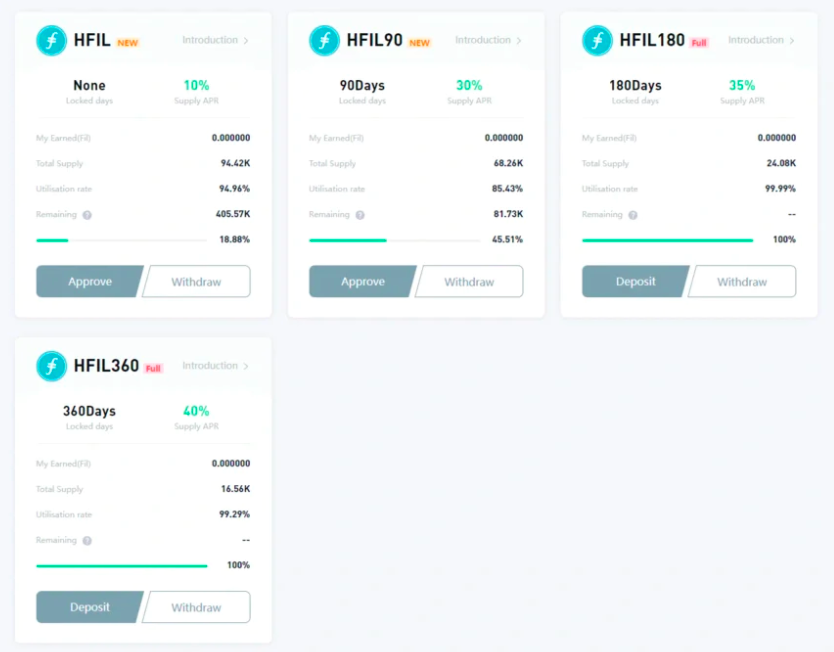
Generation package mining:
Mainly buy pledged coins and storage disks. Then rent someone else's machine and someone else's optimized code to get the encapsulation computing power.




